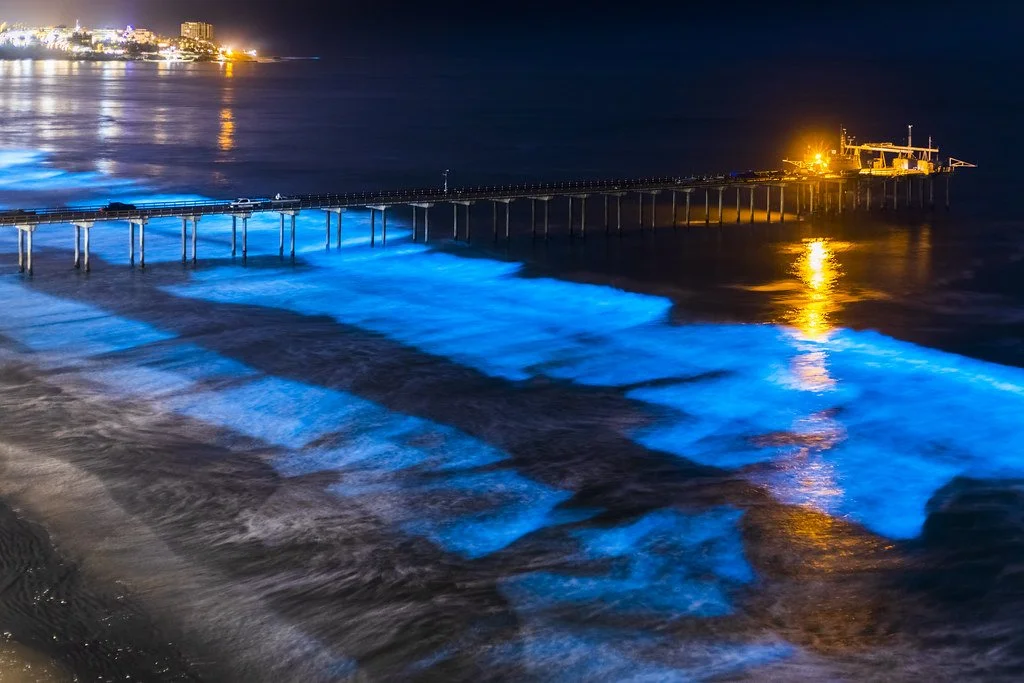The Enchanting Glow: Exploring Marine Bioluminescence
Imagine a tranquil night on the open ocean, where the water shimmers with an otherworldly glow as if sprinkled with stardust. This magical phenomenon is not a scene from a fantasy novel but a captivating natural spectacle known as marine bioluminescence. Let's dive into the mesmerising world of bioluminescent marine life, understanding what it is, how it works, and the remarkable creatures that produce this light.
What is Marine Bioluminescence?
Marine bioluminescence is the production and emission of light by living organisms in the ocean. This light is typically blue or green, the most efficient wavelength for travelling through seawater, and it is used for various purposes, from hunting and mating to defence.
How Does Bioluminescence Work?
Bioluminescence is a form of chemiluminescence where chemical reactions produce light. The basic process involves a light-emitting molecule called luciferin and an enzyme called luciferase. When luciferin reacts with oxygen, facilitated by luciferase, it produces light. This process can be triggered by various factors, such as movement, environmental changes, or even the organism's circadian rhythms.
Why Do Marine Organisms Produce Light?
Predation and Hunting: Some marine organisms use bioluminescence to attract prey. Anglerfish, for example, have a bioluminescent lure on their heads that entices smaller fish to come closer, only to be captured and eaten.
Defense Mechanisms: Many marine creatures use bioluminescence as a defence strategy. When threatened, certain species of squid and shrimp eject bioluminescent fluid to startle and confuse predators, allowing them to escape.
Communication and Mating: Bioluminescence is also used for communication, particularly during mating. Fireflies of the sea, such as certain species of ostracods, produce intricate light displays to attract potential mates.
Camouflage and Counter-Illumination: Some species use bioluminescence to blend in with their environment or to match the light filtering down from the surface, making them less visible to predators lurking below. This technique, known as counter-illumination, is used by creatures like certain types of squid.
Remarkable Bioluminescent Creatures:
Dinoflagellates: These tiny plankton are perhaps the most well-known bioluminescent organisms. When disturbed by movement, such as waves or a boat's wake, they produce a bright blue glow, creating the mesmerising effect of glowing waters.
Deep-Sea Anglerfish: Found in the ocean's dark depths, anglerfish use a bioluminescent lure to attract prey. The eerie glow of their lure stands out in the pitch-black environment, drawing in unsuspecting victims.
Jellyfish: Many jellyfish species possess bioluminescent abilities, using light displays to deter predators or to communicate with other jellyfish.
Vampire Squid: This deep-sea dweller uses bioluminescent displays to startle predators. It can emit light from the tips of its arms and produce a cloud of bioluminescent mucus.
The Importance of Studying Bioluminescence:
Researching bioluminescence enhances our understanding of marine biology and holds potential medical, biotechnology, and environmental monitoring applications. For example, bioluminescent markers are used in medical research to track cellular processes and in developing new imaging technologies.
Conclusion: A Glowing Wonder of the Oceans
Marine bioluminescence is a fascinating natural phenomenon that adds to the enchantment of our oceans. It serves as a reminder of marine life's incredible diversity and adaptability. By continuing to explore and study bioluminescence, we uncover the secrets of the deep sea and gain insights that can benefit science and humanity.
Next time you find yourself near the ocean at night, take a moment to look for the subtle glow of bioluminescent organisms. It's a magical reminder of the hidden wonders that our oceans hold, waiting to be discovered and cherished.
